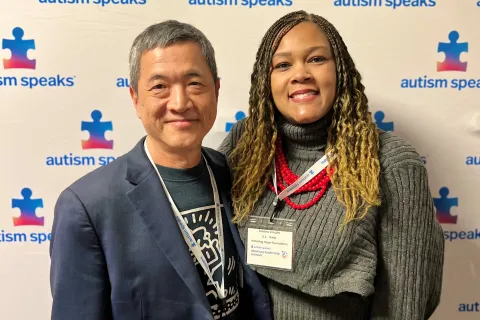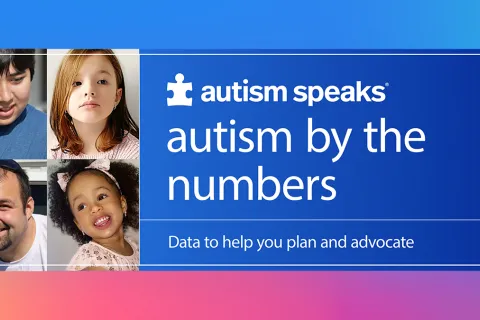Expert Q&A: How ABA therapy can help with severe behaviors
By Marta ChmielowiczSome people diagnosed with autism struggle with severe and distressing behaviors that can be destructive, harmful to the individual and others. This can impact their participation in learning and community life. These behaviors can range in intensity, but include things like aggression, self-injurious behaviors, elopement (running away) and pica (eating things that aren’t food), among others.
Applied Behavior Analysis (ABA) therapy is an evidence-based intervention that can help people with autism learn healthier behaviors and improve their quality of life. The goal of ABA is to work with the person to build skills that allow them to communicate their needs in healthier ways, reducing harmful or dangerous behaviors.
In this Q&A, Karryn Naranjo, M.A, BCBA, shares information about how ABA therapy can help reduce severe behaviors.
Born in Pereira, Colombia, Karryn has created and implemented behavior programs for children with autism and other developmental disorders in different settings: school, home and in the clinic. She is now the Behavior Intervention Division lead at the The Center for Autism and Neurodevelopmental Disorders at University of California, Irvine, a member site of the Autism Speaks-supported Autism Care Network.
How can ABA help autistic people experiencing severe behaviors? What are some of the strategies you might use?
One of the biggest benefits of ABA is that the therapy is very individualized, and every strategy is chosen based on the environment and the child’s needs.
Typically, we begin by assessing the child’s behavior, because there are many kinds of severe behaviors that might put their safety at risk. After we identify the harmful behavior, we create what we call an operational definition. We are very specific in defining what the target behavior is, what it looks like and what it doesn't look like. This helps us follow guidance and track the correct data to monitor progress.
All behavior has a function, or a reason why it's happening, so we conduct a functional behavior assessment (FBA) to understand what is causing the behavior. We look at what happens before and after the behavior to identify the reasons behind the behavior. Sometimes, behaviors have more than one function. Then, depending on the behavior and its severity, intensity and frequency, we look for strategies to reduce that behavior.
For example, let’s say a child is being aggressive towards others. When we conduct the FBA, we identify that the function of the behavior is a need for attention—the child is aggressive because they do not know how to communicate that they need someone to interact with them. We then come up with a plan to teach the child skills to communicate the need behind the behavior. For example, we might teach them how to tap someone’s shoulder or say their name to get their attention. In that way, the child will reduce the aggressive behaviors and increase the skills that will improve their interactions with their peers and the people in their community.
How do you teach a child healthier skills and behaviors?
It depends on the child’s skills and learning style. If the child learns well by repetition, we use that in some cases. If the child doesn't have great motor skills, we might use hand-over-hand guidance. If the child is nonverbal, we might use visual supports. If the child is very advanced, we might use role play. We might also use verbal directions, gestures or other prompts.
Throughout this process, we collect data to monitor progress on our goals. This might be data about the frequency or duration of a behavior. We might also collect latency data, or information about the time frame between when a person gives an instruction and the child follows through.
We often ask parents to collect this information for us because they know better than anyone how often the behavior occurs. At the end of the day, parents are the ones who need to learn the intervention strategies and follow through at home to make sure there is consistency in treatment and the child can learn and generalize their new skills.
Can you share a case study where ABA helped a family cope with a difficult behavioral situation?
R. is a 10-year-old who presented aggressive behaviors (kicking, slapping and punching others) when he wanted to use his iPad. One of the biggest issues for his mom was around bedtime. R. refused to stop using his iPad, and most nights, he engaged in tantrums with physical contact towards his mom to keep watching his screen. Mom tried different approaches to limit R.’s access to his iPad, but this caused a very tense situation at home because mom was "afraid and tired" of R.’s reactions.
From an ABA perspective, it was important to collect data on these scenarios to identify the function, or the reason for the behavior. In this case, it was clear that the function of the aggressive behavior was accessing the iPad. It was critical to then identify strategies to decrease the aggressive behavior. R. was prompted to ask verbally ("May I use the iPad?”) without engaging in physical contact with mom. Mom was guided to give access to the iPad only when this sentence was expressed in the absence of aggressive behaviors.
Different strategies to help mom limit access to the iPad were also used, such as a timer (to indicate the end of iPad time) and the use of a visual schedule with an afternoon/nighttime routine. Mom was guided to provide alternatives (different screens) when denying access to the iPad. Lastly, special instructions were provided for mom to successfully follow through when saying that the total iPad time for the day was reached.
After a few months, R. was able to understand that there were some limits to his access to the iPad, that there was a routine to follow in the afternoon and nighttime, and that aggressive behaviors wouldn’t give him access to the iPad, but requesting the iPad verbally without any aggression would give him access.
How can parents find an effective ABA practitioner?
First, find out if your insurance covers ABA and how much it covers. Then, start looking at different agencies that work with your insurance company. Paying out of pocket for this service can be very costly. Find a provider that fits your family and child's schedule. Keep in mind of the long waitlist and reach out to a few organizations. I also encourage to learn about ABA, the research behind it and how to maximize this service for your child and family.
I suggest looking for a therapist who is really tuned into the needs of the child. You want someone who can adapt their strategies depending on the child’s needs and interests, and who looks to understand the child’s motivations. That will help them approach the goal with the right reinforcer. For example, if a child likes batteries or trains, integrating that into the therapy can be very effective.
It's also important to look for a therapist who has experience with your child’s specific behaviors. Some questions to ask are: Does the therapist have knowledge about this specific matter? How are they going to be supervised? How are we going to follow through with their strategies? What data are they collecting throughout the treatment process?









